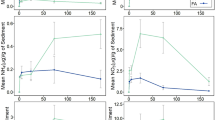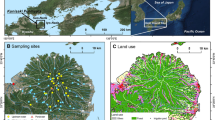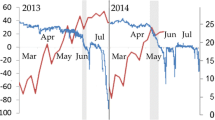Abstract
Coastal prairie wetlands (CPWs) are small, rain-fed depressions and flats that, together with their catchments, occupy approximately 40 % of the landscape around Galveston Bay, Texas, USA. Many CPWs are unregulated because they are perceived as “isolated” and a significant nexus has not been established. Results from sampling of precipitation and surface water of 12 CPWs revealed that CPWs had lower concentrations of nitrate- nitrogen (mean 18 μg L-¹) than precipitation (342 μg L-¹). A similar trend was observed for ammonia-N. Organic nutrient concentrations were several times higher in wetlands than in precipitation. Based on water budgets for six CPWs, net annual nutrient export rates indicate that CPWs are strong sinks for inorganic N and P; moderate sinks for organic N and P, and sources of dissolved organic carbon. Capture, storage, transformation, and pulsed releases of nutrients to Galveston Bay and its tributaries emphasize the role of CPWs in regulating water quality on a landscape scale. These finding demonstrate a nexus with navigable waters.




Similar content being viewed by others
References
Agren A, Buffam I, Berggren M, Bishop K, Jannson M, Landon H (2008) Importance of seasonality and small streams for the landscape regulation of dissolved organic carbon export. J Geophys Res 112:1–11
Alvarez-Cobelas M, Sanchez-Carrillo S, Angeler DG, Sanchez-Andres R (2009) Phosphorus export from catchments: a global view. J N Am Bentholl Soc 28(4):805–820
Bedford BL (1996) The need to define hydrologic equivalence at the landscape scale for freshwater wetland mitigation. Ecol Appl 6:57–68
Bowden WB (1987) The biogeochemistry of nitrogen in freshwater wetlands. Biogeochemistry 4:313–348
Byun D (2008) Analysis of atmospheric deposition of nitrogen and sulfur in the Houston-Galveston airshed affecting water quality. Final Report for Texas Commission on Environmental Quality/EPA. Contract Number 582-7-77821
Cape JN, Cornell SE, Jickells TD, Nemitz E (2011) Organic nitrogen in the atmosphere – where does it come from? A review of sources and methods. Atmos Res 102:30–48
Clapp AG (2010) Hydrology of non-riverine freshwater wetlands of the upper Texas coast. Masters thesis. Baylor University, Waco, Texas
Clark GM, Mueller DK, Mast MA (2000) Nutrient concentrations and yields in undeveloped stream basins of the United States. Am Water Resour Assoc 36:849–860
Comer P, Goodin K, Tomaino A, Hammerson G, Kittel G, Menard S, Nordman C, Pyne M, Reid M, Sneddon L, Snow K (2005) Biodiversity values of geographically isolated wetlands in the United States. NatureServe, Arlington
Demissie M, Khan A (1993) Influence of wetlands on streamflow in Illinois. Contract Report 561, Office of Sediment & Wetland Studies, Prepared for the Illinois Department of Conservation Illinois State Water Survey Hydrology Division, Champaign, Illinois
Downing JA, Prairie YT, Cole JJ, Duarte CM, Tranvik LJ, Striegl RG, McDowell WH, Kortelainen P, Caraco NF, Melack JM, Middelburg JJ (2006) The global abundance and size distribution of lakes, ponds, and impoundments. Limnol Oceanogr 51:2388–2397
Enwright N, Forbes MG, Doyle RD, Hunter B, Forbes W (2011) Using geographic information systems to inventory Coastal Prairie Wetlands along the Upper Gulf Coast, Texas. Wetlands 31(4): 687–697
Flynn AM (2008) Organic matter and nutrient cycling in a Coastal Plain estuary: carbon, nitrogen, and phosphorus distributions, budgets, and fluxes. J Coast Res 55:76–94
Grace JB, Allain LK, Baldwin HQ, Billock AG, Eddleman WR, Given AM, Jeske CW, Moss R (2005) Effects of prescribed fire in the coastal prairies of Texas. USGS Open file report, pp 2005–1287
Harrison JA, Caraco N, Seitzinger SP (2005) Global patterns and sources of dissolved organic matter export to the coastal zone: results from a spatially explicit, global model. Global Biogeochem Cycles 19:GB4S04. doi:10.1029/2005GB002480
Hayakawa A, Shimizu M, Woli KP, Kuramochi K, Hatano R (2006) Evaluating stream water quality through land use analysis in two grassland catchments: impact of wetlands on stream nitrogen concentration. J Environ Qual 35(2):617–627
Hopkinson CS Jr (1992) A comparison of ecosystem dynamics in freshwater wetlands. Estuaries 15:549–562
Howarth RW (1998) An assessment of human influences on fluxes of nitrogen from the terrestrial landscape to the estuaries and continental shelves of the North Atlantic Ocean. Nutr Cycl Agroecosyst 52:213–223
Howarth RW, Boyer EW, Pabich WJ, Galloway JN (2002) Nitrogen use in the United States from 1961–2000 and potential future trends. Ambio 31:88–96
Imai A, Fukushima T, Matsushige K (1999) Effects of iron limitation and aquatic humic substances on the growth of Microcystis aeruginosa. Can J Fish Aquat Sci 56(10):1929–1937
Jacob JS, Lopez R (2005) Freshwater, non-tidal wetland loss, lower Galveston Bay watershed 1992–2002: a rapid assessment method using GIS and aerial photography. Texas Coastal Watershed Program, GBEP 582-3-53336
Mannino A, Harvey HR (2004) Black carbon in estuarine and coastal ocean dissolved organic matter. Limnol Oceanogr 49(3):735–740
Meyers T, Sickles J, Dennis R, Russell K, Galloway J, Church T (2001) Atmospheric nitrogen deposition to coastal estuaries and their watersheds. In: Valigura RA, Alexander RB, Castro MS, Meyers TP, Paerl HW, Stacey PE, Turner RE (eds) Nitrogen loading in coastal water bodies: an atmospheric perspective. American Geophysical Union, Coastal and Estuarine Studies, vol. 57, pp 53–76
Miller WL, Bragg AL (2007) Soil characterization and hydrological monitoring project, Brazoria county, Texas, bottomland hardwood vertisols. United States Department of Agriculture, Natural Resources Conservation Service, Temple
Moulton DW, Dahl TE, Dall DM (1997) Texas coastal wetlands, status and trends, mid-1950s to early 1990s. U.S. Fish and Wildlife Service, Southwestern Region Albuquerque, New Mexico, p 32
Mulholland PJ, Kuenzler EJ (1979) Organic carbon export from upland and forested wetland watersheds. Limnol Oceanogr Notes 24(5):960–966
Newell CJ, Rifai HS, Bedient PB (1992) Characterization of nonpoint sources and loadings to Galveston bay. Galveston Bay Estuary Program, Webster, p 191
Newman MC, Schalles JF (1990) The water chemistry of Carolina bays: a regional survey. Arch Fur Hydrobiol 118:147–168
Opsahl SP (2005) Organic carbon composition and oxygen metabolism across a gradient of seasonally inundated limesink and riparian wetlands in the southeast Coastal Plain USA. Biogeochemistry 76:47–68
Pellerin BA, Wollheim WM, Hopkinson CS, McDowell WH, Williams MR, Vörösmarty CJ, Daley ML (2004) Role of wetlands and developed land use on dissolved organic nitrogen concentrations and DON/TDN in Northeastern U.S. rivers and streams. Limn and Oceanog 49:910–918
Pinckney JL (2006) System-scale nutrient fluctuations in Galveston Bay, Texas (USA). In: Kromkamp JC, de Brouwer JFC, Blanchard GF, Forster RM, Creách V (eds) Functioning of microphytobenthos in Estuaries. Royal Netherlands Academy of Arts and Sciences, Amsterdam, pp 141–164
Qualls RG, Richardson CJ (2003) Factors controlling concentration, export, and decomposition of dissolved organic nutrients in the Everglades of Florida. Biogeochemistry 62:197–229
Scavia D, Bricker S (2006) Coastal eutrophication assessment in the United States. Biogeochemistry 79:187–208
Schiff S, Aravena R, Mewhinney E, Elgood R, Warner B, Dillon P, Trumbore S (1998) Precambrian shield wetlands: Hydrologic control of the sources and export of dissolved organic matter. Clim Change 40:167–188
Sipocz A (2005) The Galveston Bay wetland crisis. National Wetlands Newsletter 27(4):5, Environmental Law Institute
Smith SV, Renwick WH, Bartley JD, Buddemeier RW (2002) Distribution and significance of small, artificial water bodies across the United States landscape. Sci Total Environ 299:21–36
Tiner RW (2003a) Estimated extent of geographically isolated wetlands in selected areas of the United States. Wetlands 23:636–652
Tiner RW (2003b) Geographically isolated wetlands of the United States. Wetlands 23:494–516
U.S. Army Corps of Engineers (2008) Clean water act jurisdiction following the U.S. Supreme Court’s decision in Rapanos v. United States & Carabell v. United States. www.usace.army.mil/CECW/Documents/cecwo/reg/cwa_guide/cwa_juris_2dec08.pdf
U.S. Army Corps of Engineers, U.S. Environmental Protection Agency (2011) Guidance on identifying waters protected by the clean water act. May 2, 2011
Vitousek PM, Mooney HA, Lubchenco J, Melillo JM (1997) Human domination of earth’s ecosystems. Science 25:494–499
Warnken KW, Santschi PH (2004) Biogeochemical behavior of organic carbon in the Trinity River downstream of a large reservoir lake in Texas, USA. Sci Total Environ 29:131–144
Weller CM, Watzin MC, Wang D (1995) Role of wetlands in reducing phosphorus loading to surface water in eight watersheds in the Lake Champlain Basin. Environ Manag 20:731–739
Whigham DF, Jordan TE (2003) Isolated wetlands and water quality. Wetlands 23:541–49
Wilcox B, Dex D, Jacob J, Sipocz A (2011) Evidence of surface connectivity for Texas Gulf coast depressional wetlands. Wetlands. doi:10.1007/s13157-011-0163-x
Wilson HW, Xenopoulos MA (2008) Ecosystem and seasonal control of stream dissolved organic carbon along a gradient of agricultural land use. Ecosystems 11:555–568
Acknowledgements
We thank Stephen Johnston and the Galveston Bay Estuary Program, the Texas Commission on Environmental Quality, the Texas General Land Office, the Environmental Protection Agency, and the Association of American Geographers Anne White Fund for funding this research. We thank Nicholas Enwright and Dr. Bruce Hunter of the University of North Texas for GIS support and graphics; and Andy Sipocz, Dr. John Jacobs, Wes Miller, Mark Kramer, Jim Herrington, Jamie Schubert and others for sharing their knowledge of coastal prairie wetlands. We thank Dow Chemical, Armand Bayou Nature Center, Don Wilcox and other landowners that allowed us access to their CPWs. We are particularly grateful for the dedication and continual support provided by Adam Clapp and Joe Yelderman, who conducted the hydrologic monitoring that made these calculations possible. Finally, we thank CRASR and Baylor University for supporting this project in numerous ways.
Author information
Authors and Affiliations
Corresponding author
Rights and permissions
About this article
Cite this article
Forbes, M.G., Back, J. & Doyle, R.D. Nutrient Transformation and Retention by Coastal Prairie Wetlands, Upper Gulf Coast, Texas. Wetlands 32, 705–715 (2012). https://doi.org/10.1007/s13157-012-0302-z
Received:
Accepted:
Published:
Issue Date:
DOI: https://doi.org/10.1007/s13157-012-0302-z




